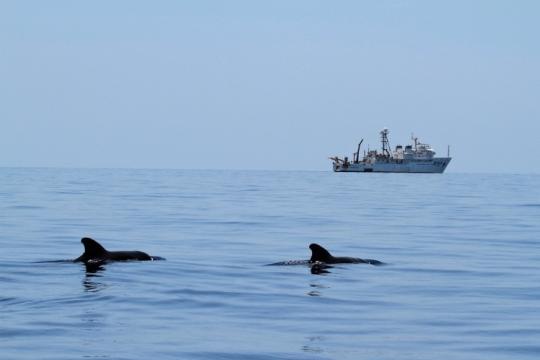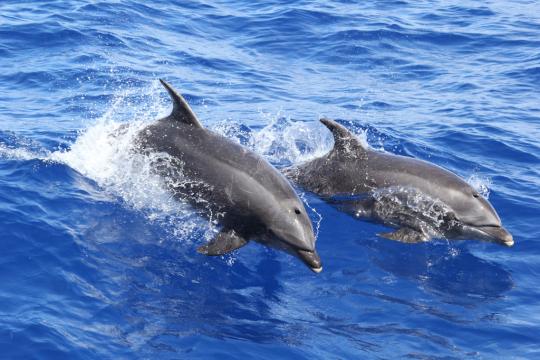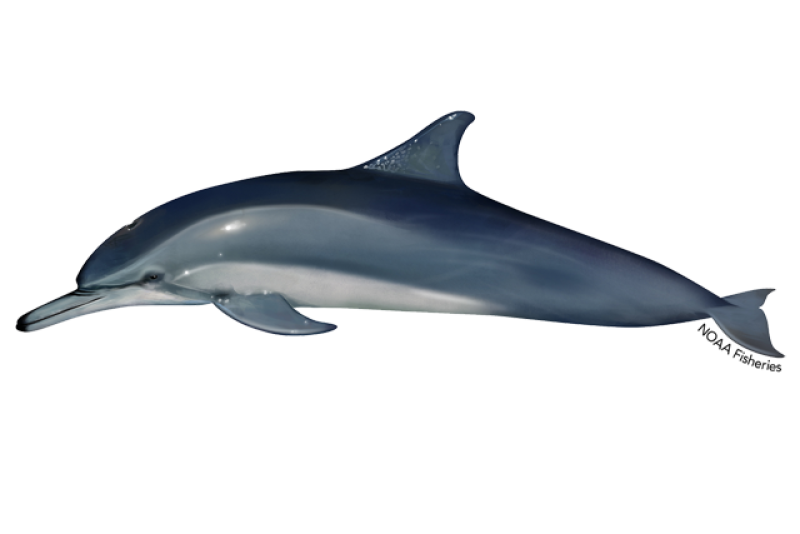Atlantic Spotted Dolphin
Stenella frontalis

Protected Status
Quick Facts
 Atlantic spotted dolphin swimming in the ocean. Credit: NOAA Fisheries
Atlantic spotted dolphin swimming in the ocean. Credit: NOAA Fisheries
Atlantic spotted dolphin swimming in the ocean. Credit: NOAA Fisheries
About the Species
 Atlantic spotted dolphin swimming in the ocean. Credit: NOAA Fisheries
Atlantic spotted dolphin swimming in the ocean. Credit: NOAA Fisheries
Atlantic spotted dolphin swimming in the ocean. Credit: NOAA Fisheries
Atlantic spotted dolphins are found in warm temperate and tropical waters of the Atlantic Ocean. They usually form groups of five to 50 individuals but sometimes travel in groups of up to 200. They are fast swimmers and often “surf” in the waves created by vessels.
Young Atlantic spotted dolphins do not have spots. As a result, they can look like slender bottlenose dolphins. They have a distinctive blaze that sweeps up along their sides. Their characteristic spotted pattern starts to appear all over their bodies as they get older.
Atlantic spotted dolphins, like all marine mammals, are protected under the Marine Mammal Protection Act.
NOAA Fisheries and its partners are working to conserve Atlantic spotted dolphins and further our understanding of this species through research and conservation activities.
Population Status
NOAA Fisheries estimates population size in our stock assessment reports.
The worldwide population of Atlantic spotted dolphins is unknown. Scientists estimate that there are over 77,000 Atlantic spotted dolphins in U.S. waters.
To manage Atlantic spotted dolphins in U.S. waters, we have divided them into three stocks:
- Northern Gulf of America* (formerly Gulf of Mexico) stock
- Puerto Rico and U.S. Virgin Islands stock
- Western North Atlantic stock
Based on the most recent surveys, our scientists estimate that there are about 21,506 dolphins in the Gulf of America stock and about 31,506 dolphins in the western North Atlantic stock. The number of dolphins in the Puerto Rico and U.S. Virgin Islands stock is unknown.
Appearance
Atlantic spotted dolphins are about 5 to 7.5 feet long and weigh about 220 to 315 pounds. They have a robust body with a tall, curved dorsal fin located midway down their back. Their beaks are moderately long. Like other cetaceans, their head has a distinctive melon, a rounded forehead that collects sounds from the environment. They have 30 to 42 pairs of small, cone-shaped teeth in each jaw.
Atlantic spotted dolphins’ color patterns vary with age and location. Young dolphins do not have any spots. Instead, they have a dark gray back with a pale white underside. This lack of spots can make young Atlantic spotted dolphins look like slender bottlenose dolphins. An Atlantic spotted dolphin starts to develop spots after one year. As the dolphin matures, the spots become darker and more widespread, especially on its back.
Behavior and Diet
Atlantic spotted dolphins are usually found in groups of less than 50 individuals but sometimes travel in groups of up to 200. In coastal waters, groups usually consist of five to 15 individuals. Within these groups, the dolphins are sometimes organized by age or sex. Atlantic spotted dolphins blow bubbles through their blowholes as one way to communicate with members of their group. They also communicate with sound.
Atlantic spotted dolphins are often described as “acrobatic” swimmers, frequently leaping out of the water or jumping at the water’s surface. They can also swim very quickly and often “surf” in the waves created by vessels. They sometimes interact with other cetacean species, such as bottlenose dolphins.
Atlantic spotted dolphins can dive up to 200 feet and have been recorded holding their breath for up to ten minutes. Most of their dives are less than 30 feet and last for 2 to 6 minutes. These dolphins eat small fish, invertebrates, and cephalopods, such as squid and octopi. They have 30 to 42 pairs of small, cone-shaped teeth in each jaw. Groups of dolphins often coordinate their movements to catch prey together. Individuals sometimes use their beaks to dig into the sand on the ocean bottom to catch hidden fish.
Where They Live
Atlantic spotted dolphins are found in warm temperate, subtropical, and tropical waters throughout the Atlantic Ocean. Their range includes the waters of the U.S. East Coast (Southern New England to Gulf of America), the Bahamas, Brazil, the Azores and Canary Islands, and Gabon.
Atlantic spotted dolphins prefer the waters along the continental shelf (the edge of a continent below the ocean’s surface). They usually live in coastal or continental shelf waters that are 65 to 820 feet deep, but are also found in deeper oceanic waters. Warm currents such as the Gulf Stream may affect their distribution.
Lifespan & Reproduction
The estimated lifespan of Atlantic spotted dolphins is unknown. They reach sexual maturity when they are 8 to 15 years old. Females give birth to a single calf every 1 to 5 years. Mothers nurse their calves for 1 to 5 years.
Threats
Entanglement
One of the main threats to Atlantic spotted dolphins is getting caught in fishing gear. Dolphins can become entangled or captured in commercial fishing gear such as pelagic longline and shrimp trawl gear These interactions can cause dolphins to be injured or killed by entanglement in the gear.
Ocean Noise
Underwater noise pollution interrupts the normal behavior of Atlantic spotted dolphins that rely on sound to communicate and echolocate. If loud enough, noise can cause permanent or temporary hearing loss. Noise interference from vessels, as well as industrial and military activities, disturbs Atlantic spotted dolphins’ feeding, communication, and orientation.
Illegal Feeding and Harassment
Atlantic spotted dolphins sometimes interact with different types of fishing vessels, often following them and eating discarded catch. A few Atlantic spotted dolphins have been hunted and killed in the Caribbean, South America, West Africa, and other offshore islands for food and bait.
*Executive Order 14172, “Restoring Names That Honor American Greatness” (Jan. 20, 2025), directs that the Gulf of Mexico be renamed the Gulf of America. Gulf of America references in this website refer to the same area as the Gulf of Mexico in the applicable regulations under 50 CFR parts 216–219, 222–226, and 600–699. The name change did not result in any changes to, and had no effect on the applicability or enforceability of, any existing regulations. This website continues to use “Gulf of Mexico” when quoting statutes, existing regulations, or previously published materials.
Scientific Classification
| Kingdom | Animalia | Phylum | Chordata | Class | Mammalia | Order | Cetacea | Family | Delphinidae | Genus | Stenella | Species | frontalis |
|---|
Last updated by NOAA Fisheries on 04/24/2025
What We Do
Conservation & Management
NOAA Fisheries is committed to the protection of Atlantic spotted dolphins. Targeted management actions taken to secure protections for these dolphins include:
- Overseeing marine mammal health and stranding response
- Addressing ocean noise
- Educating the public about Atlantic spotted dolphins and the threats they face
Science
Our research projects have discovered new aspects of Atlantic spotted dolphin biology, behavior, and ecology and helped us better understand the challenges that all Atlantic spotted dolphins face. Our work includes:
- Stock assessments
- Monitoring population abundance and distribution
How You Can Help
Keep Your Distance
Be responsible when viewing marine life in the wild. Observe all dolphins and porpoises from a safe distance of at least 50 yards and limit your time spent observing to 30 minutes or less.
Report Marine Life in Distress
Report a sick, injured, entangled, stranded, or dead animal to make sure professional responders and scientists know about it and can take appropriate action. Numerous organizations around the country are trained and ready to respond. Never approach or try to save an injured or entangled animal yourself—it can be dangerous to both the animal and you.
Learn who you should contact when you encounter a stranded or injured marine animal
Report a Violation
Call the NOAA Fisheries Enforcement Hotline at (800) 853-1964 to report a federal marine resource violation. This hotline is available 24 hours a day, 7 days a week for anyone in the United States.
You may also contact your closest NOAA Office of Law Enforcement field office during regular business hours.
Don't Feed Wild Dolphins
Dolphins fed by humans lose their natural wariness and learn to associate people with food, causing them to beg for handouts and take bait and catch directly from fishing gear. This puts them at risk from vessel strikes and becoming entangled in or ingesting fishing gear. Dolphins may teach these behaviors to their young, thereby putting them at risk.
More on protecting wild dolphins and admiring them from a distance
Featured News
 Rice's Whale. Credit: NOAA Fisheries
Rice's Whale. Credit: NOAA Fisheries
Protecting Species While Planning for Offshore Wind Development in the U.S. Gulf of Mexico
 Pilot whales surface near the NOAA Ship Gordon Gunter. Credit: NOAA Fisheries/Melody Baran (Permit # 14450)
Pilot whales surface near the NOAA Ship Gordon Gunter. Credit: NOAA Fisheries/Melody Baran (Permit # 14450)
 Pair of bottlenose dolphins. Credit: NOAA Pacific Islands Fisheries Science Center/Lisa Morse.
Pair of bottlenose dolphins. Credit: NOAA Pacific Islands Fisheries Science Center/Lisa Morse.
 A humpback mother and calf swimming off the West Coast. Credit: NOAA Fisheries/Ed Lyman. NOAA Fisheries Permit #14682.
A humpback mother and calf swimming off the West Coast. Credit: NOAA Fisheries/Ed Lyman. NOAA Fisheries Permit #14682.
Join NOAA Fisheries in Celebrating the 50th Anniversary of the Marine Mammal Protection Act
Management Overview
The Atlantic spotted dolphin is protected throughout its range under the Marine Mammal Protection Act.
Additionally, the Atlantic humpback dolphin is listed under:
- Appendix II of the Convention on International Trade in Endangered Species of Wild Fauna and Flora (CITES)
- Annex II of the Protocol for Specially Protected Areas and Wildlife (SPAW)

Conservation Efforts
Overseeing Marine Mammal Health and Stranding Response
We work with volunteer networks in all coastal states to respond to marine mammal strandings including all dolphins and porpoises. When stranded animals are found alive, NOAA Fisheries and our partners assess the animal’s health and determine the best course of action. When stranded animals are found dead, our scientists work to understand and investigate the cause of death. Although the cause often remains unknown, scientists can sometimes attribute strandings to disease, harmful algal blooms, vessel strikes, fishing gear entanglements, pollution exposure, and underwater noise. Some strandings can serve as indicators of ocean health, giving insight into larger environmental issues that may also have implications for human health and welfare.
Learn more about the Marine Mammal Health and Stranding Response Program
Marine Mammal Unusual Mortality Events
Atlantic spotted dolphins have been part of a declared unusual mortality event in the past. Under the Marine Mammal Protection Act, an unusual mortality event is defined as "a stranding that is unexpected; involves a significant die-off of any marine mammal population; and demands immediate response." To understand the health of marine mammal populations, scientists study unusual mortality events.
Get information on active and past UMEs
Get an overview of marine mammal UMEs
Addressing Ocean Noise
Underwater noise threatens dolphin populations, interrupting their normal behavior and driving them away from areas important to their survival. Increasing evidence suggests that exposure to intense underwater sound in some settings may cause some dolphins to strand and ultimately die. NOAA Fisheries is investigating all aspects of acoustic communication and hearing in marine animals, as well as the effects of sound on whale behavior and hearing. In 2018, we updated the marine mammal acoustic technical guidance for assessing the effects of anthropogenic (human-caused) sound on marine mammals’ hearing.
Educating the Public
NOAA Fisheries aims to increase public awareness and support for Atlantic spotted dolphin conservation through education, outreach, and public participation. We share information with the public about the status of Atlantic spotted dolphins, as well as our research and efforts to promote their recovery.
Regulatory History
All marine mammals, including Atlantic spotted dolphins, are protected in the United States under the MMPA.
Key Actions and Documents
Last updated by NOAA Fisheries on 04/24/2025
Science Overview
NOAA Fisheries conducts various research activities on the biology, behavior, and ecology of Atlantic spotted dolphins. The results of this research are used to inform management decisions for this species.
Stock Assessments
Determining the size of Atlantic spotted dolphin populations helps resource managers determine the success of conservation measures. Our scientists collect population information and present the data in annual stock assessment reports.
Monitoring Population Abundance and Distribution
Scientists observe Atlantic spotted dolphins to record their numbers and distribution. By comparing numbers collected over multiple years, scientists can look for trends—i.e., whether the population is increasing, decreasing, or remaining stable during a given period.
More Information
Last updated by NOAA Fisheries on 04/24/2025
Documents
Biological Opinion on the Issuance of Permit No. 20455 to Randall Wells for Research on Bottlenose and Atlantic Spotted Dolphins
This biological opinion is NOAA Fisheries' opinion on the effects of the permit No. 20455 for…
Research
Population Consequences of the Deepwater Horizon Oil Spill on Pelagic Cetaceans
We quantified population consequences for pelagic cetaceans, including sperm whales, beaked whales,…
Outreach & Education
Dolphin Friendly Fishing Tips Sign
This sign is often posted near boat ramps, piers, docks, marinas, and waterfront parks.
Protect Wild Dolphins Sign
This sign is often posted near boat ramps, piers, docks, marinas, and waterfront parks.
Don't Feed Wild Dolphin Sign
This sign is often posted near boat ramps, piers, docks, marinas, and waterfront parks.
Last updated by NOAA Fisheries on 04/24/2025



